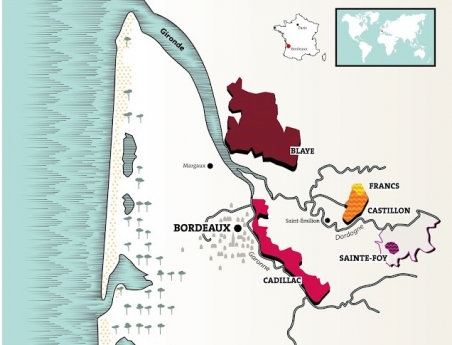
28 AUG 2018 Why Côtes de Bordeaux Should be Your Go-To French WineMost wine drinkers know of the great wines of Bordeaux. But the Côtes de Bordeaux? That’s unfamiliar territory. This hilly area, located on the Right Bank, was first formed in 2009 with the union of four regions: Côtes de Blaye, Côtes de Castillon, Côtes de Francs and Côtes de Cadillac. In 2016, Sainte-Foy Bordeaux joined the group. Together, they cover nearly 30,000 acres of vines, and represent 10 percent of total production of Bordeaux. What’s wonderful about these regions is that each has a distinct terroir. They produce vastly different styles of wines, so there’s something for everyone. To help wine drinkers identify style, the labels contain both the broader appellation—Côtes de Bordeaux—as well as the specific region. “It’s like a family,” says Aurélie Lascourrèges, a spokesperson for Union des Côtes de Bordeaux. “Every one is different, but they do have points in common, particularly their long history, their hilly landscape and their closeness to the rivers [the Gironde, the Garonne and the Dordogne], which affect their climates.” The Appellation d’Origine Contrôlée (AOC) is young, so there are new winemakers and bottles to be are discovered all the time. And the best part? These wines currently represent some of the best values in Bordeaux, and with three great vintages on the market (2014, 2015, and 2016), there’s a lot to choose from. Here’s a closer look at these five regional stars. Blaye Côtes de Bordeaux Blaye was an important river port in Roman times, and played a role in the Hundred Years War. Today, the Citadel of Blaye is a UNESCO World Heritage Site. This region is by far the largest of the five in the appellation. It’s also the source of great accessible reds, driven by fresh, fruity-forward notes. With great prices, the wines are ready to drink after three to four years. They also offer some ripe, wood-aged whites. Castillon Côtes de Bordeaux Next-door Saint-Émilion has had a huge influence on Castillon. In fact, the Saint-Émilion growers and chateau owners have taken advantage of lower-vineyard prices in Castillion too: They’ve purchased land to produce some serious wines. You’ll find Saint-Émilion-style wines—mainly Merlot and Cabernet Franc—to be rich with character, but at a quarter of the price. Francs Côtes de Bordeaux A tiny jewel located next to Castillon, Francs is the smallest and most rural region at about 435 hectares (1,074 acres) and it’s closer to Bergerac than the city of Bordeaux. The famous Bordeaux family, the Thienponts—who have many chateaus throughout the region, including in Pomerol and Saint-Émilion—also have vineyards in Francs, where they produce delicious and age-worthy whites and reds. Cadillac Côtes de Bordeaux In the 18th century, Antoine de la Mothe Cadillac, the Knight of Lamothe-Cadillac, a great connoisseur of wine, was sent as a governor to Louisiana, and brought his favorite wine with him: a Cadillac Côtes de Bordeaux. His name was given to the car some 150 years later. The wines produced on this dramatic, sloping landscape along the Garonne river, are classic Bordeaux: rich with black currants, structured tannins and have the ability to age. They also produce some sweet white wine. Sainte-Foy Côtes de Bordeaux It’s no surprise that, the newest member of the AOC is also the least known. The area surrounds the historic town of Sainte-Foy-la-Grande, with vineyards located alongside the Dordogne River. This region still has a lot to learn about how to producing high-quality wines, but it’s worth watching.
Sourced: Voss, G. (2018) Wine Enthusiast Magazine : Why Côtes de Bordeaux Should be Your Go-To French Wine. Available : tinyurl.com/yb2knlyt (accessed Aug 28, 2018)
|
Archive
|







